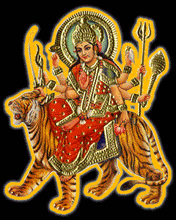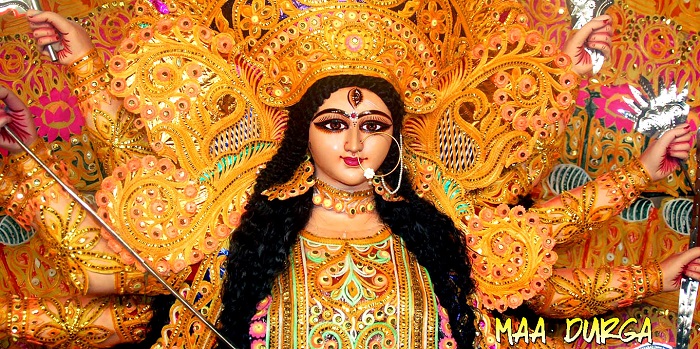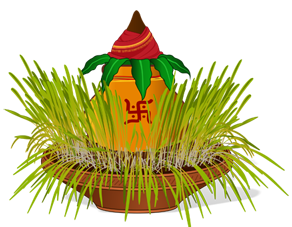Navratri Puja Vidhi - Procedure of Navratri Pooja

Navratri is amongst the most auspicious festival of Hindus that is celebrated in the honor of nine different forms of the Goddess Durga. know the Puja Vidhi and rules for fasting.
Navratri is amongst the most important Hindu festivals. This auspicious festival is celebrated with great zeal and devotion throughout the country. The literal meaning of 'Navratri' is 'nine auspicious nights'. Navratri is a pious festival celebrated in the honor of nine different forms of the Goddess Durga, Lakshmi and Saraswati for nine continuous days. The Goddess of Power is worshipped during these days in order to seek her blessings and protection from any unknown fear and possible threat. The devotees ask for peace and prosperity from the Goddess. The Goddess of power has the supremacy over the creation, preservation and destruction of the universe.
Navratri is being celebrated in our country adhering to all the customs and rituals. It is of utmost importance to know the exact method of performing the Navratri Pooja. Here, is the full Navratri Pooja Vidhi.
Items to be required for the Navratri Pooja:
- Picture or Idol of Goddess Durga in the Pooja room
- A dupatta or sari to offer to the deity
- Durga Saptshati book
- Ganga water or plain water in Kalash (pitcher)
- Fresh and washed mango leaves
- Fresh grass
- Sandalwood
- One coconut
- Roli, red sacred powder for tilak
- Moli, red sacred thread
- Rice
- Supari (Areca nuts)
- Paan (Betel leaves)
- Cloves
- Cardamom
- Kumkum (vermilion)
- Gulal
You will need incense sticks, a 'deep' and a matchstick. You will also require some fresh flowers like rose, jasmine or red hibiscus. You may offer fresh fruits and sweets such as 'laddoo', or 'peda' for prasad. Take a mat, to sit. If possible, every member of the house should sit together.
Navratri Pooja Vidhi:
Certain items are required to perform the Navratri pooja. These may include the idol or picture of Goddess Durga, Durga Sapthashati book, water in Kalash (pitcher), fresh washed mango leaves, one coconut, roli (red color for tilak), moli (red sacred thread), chawal (rice), paan (betel leaves), supari (beetle nuts), cloves, cardamom, kumkum (vermilion) and gulal. You will also need few incense sticks, a deep and matchstick. The flowers used for Navratri puja may include rose, lotus and red hibiscus. Stalks of Bilwa (bael) leaves are also used for the puja. You may offer fresh pomegranate and sweets such as laddoo and peda, as prasad. You will require a Panchpatra containing spoon and water, bael leaves. Take a mat as well, to sit.

In order to perform the puja, take bath in the morning and wear laundered clothes. Then, fill the kalash with water and place mango leaves on its mouth. Place a coconut inside the kalash. Now, tie moli on the neck of the pitcher. Place the idol or picture of Ma Durga at your puja room and then worship the deity with roli, rice, flowers, balepatra, kumkum and gulal. Thereafter, you may add burning coal to a clay pot and pour ghee (clarified butter) over it. Offer a small piece of the sweetmeat to the fire. Keep adding ghee to the fire at regular intervals. Make sure that you maintain the light throughout your puja. Once the puja is over, fold your hands and encircle the flame for three times. Light the incense sticks and deep and perform the aarti. You may sing arti song while doing the aarti. You may chant Durga Saptashati or Devi Kavach or ask a pundit to do it, to conclude the puja.
For 'Kalash Sthapna':

Place the kalash near the idol or picture of the deity and fill it with pure water. Place mango leaves on the mouth of the kalash. Place a coconut inside the kalash. Tie moli around the neck of the kalash.
Sprinkle 'Gangajal' all over the Puja room. Now, offer sandalwood powder and some fresh grass to the Goddess. Then, offer the sari or dupatta to the Goddess. Place some fresh flowers in front of the Goddess. Next, offer 'paan' with a clove placed on it. If you are married, then offer two such paans. Light 'agarbatti' or incense sticks. Perform 'havan' using this mantra- "Om aing hreeng kleeng chamundaya vichche namah". Give aahuti for 11 times. Fold your hands and pray. At last, offer prasad and do aarti of Goddess Durga. Sing the "Kshama Prarthana" of the 13th chapter of sacred Durga Saptshati and conclude the Puja. Pray with whole heart.
The Durga Saptashati book should be kept carefully and respectfully.
Celebration of 'Mahanavami' in India:
The ninth day of Navratri, popularly known as 'Mahanavami' is the final day of Navratri celebrations. The celebration of 'Mahanavami' varies from state to state in India.
People of different states celebrate Mahanavami in their own way. People from Haryana, Uttar Pradesh, Bihar and Punjab do 'Kanya Puja' on the last day. On the concluding day, nine young girls are invited in the house and feasted with delicious food. These nine young girls are treated as the nine forms of the Goddess. They are welcomed by washing their feet and putting tilak on their forehead.
The people of Kerala celebrate Saraswati Pooja on 'Ashtami', the eighth day or the day before Mahanavami. The concluding day is treated as the resting day. People do not begin with any new work and even children do not study this day.
Navratri celebrations end on 'Ashtami' instead of Mahanavami in some parts of Uttar Pradesh, Haryana, Kashmir and Maharashtra.
The people of West Bengal celebrate Durga Pooja with great enthusiasm and devotion. Huge 'Pandal' (tent) is set up and a huge idol of Goddess Durga is installed in the 'Pandal' and worshipped. On Mahanavami, the idol of Goddess Durga is bid adieu and immersed in the sea or river or any flowing source of water.
The festival of Navratri is divided into the sets of three days. These sets are formulated to worship the different forms of the Goddess. On the first three days, Goddess Durga is revered and worshipped. She is known to be the master of power and eliminates all the evil and fear from the mind and life of the devotees. The next three days are devoted to the Goddess of wealth- Lakshmi. She showers the blessings of never-ending wealth upon her devotees. The final set of three days is devoted for worshipping the Goddess of wisdom- Saraswati. She is responsible for spiritual enlightenment and success in life.
Navratri is a festival of sentiments, positive thoughts, peace and prosperity. Every year it is welcomed with great respect and love. People refrain from wrong deeds and indulge in pure devotion. Wish you a Happy Navratri!